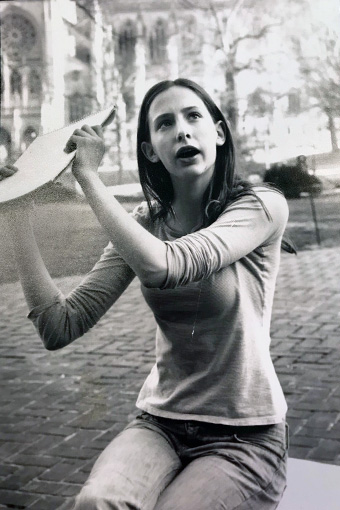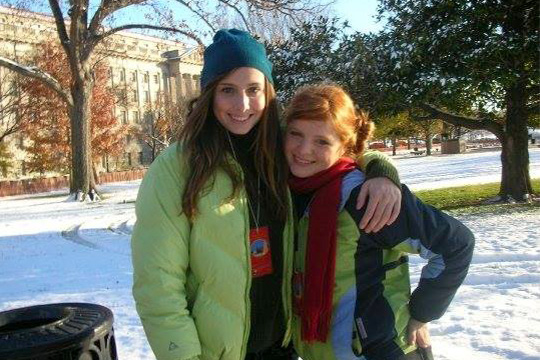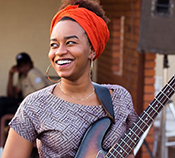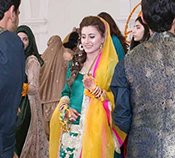Bringing more of Music's Potential to the World.
(Part 1)
Kate Eberstadt / Artist, Community Supporter
Connecting with Asylum-Seeking Children Through the Power of Music.
What can music do for people who have suffered great hardship? Kate Eberstadt found answers to this question through a music education project she established for children living as refugees in Berlin. Music, she tells us, provided an unparalleled channel of communication. We asked about how she started this undertaking. The following is a summary of our interview with Kate.
Music taught me important lessons about life.
My first memory of music is at around the age of four, singing with the congregation at church in my hometown of Washington, D.C. Piano lessons came two years later, and by age ten I wrote my first composition. I was introverted as a child, and music gave me a means to express myself. Music provided another avenue for me to forge connections with other people and helped a shy child like myself with making friends.
As a freshman, I joined my high school coed choir. Building harmonies in a large group was a completely different experience from sitting alone at the piano or even singing in a smaller group. At first, I didn’t sign up - shyness had dissuaded me from participating in the co-ed extra-curricular. Then the choir conductor, Benjamin Hutto, strongly encouraged me to sign up, and changed my mind.
Mr. Hutto was to have an enormous influence on my life. An accomplished and well-known musician in his own right, he believed in the importance of music in the development of young people and put everything he had into conducting the Chorale. On principle, our chorale was not audition based; he would accept any singer who wanted to learn. Of us, he only asked that we adhere to two principles: show up and try your best. Through Mr. Hutto’s mentoring, I discovered the beautiful community that could be formed by a group commitment to these principles. This became an important lesson for working with others, not only in the field of music, but in many aspects of life.

Art has the power to transcend cultural and linguistic differences.
Under the guidance of Mr. Hutto, I devoted to the music program at my school, and was ultimately elected president of the chorale. Other musical pursuits followed in high school and university: learning orchestral arrangement, composing for a-cappella groups, writing songs in various genres, performing in a band, and producing and selling CDs.
Another big artistic influence I encountered at university was the performing arts program run by the globally-recognized theatre director Robert Wilson. Ninety artists from 27 countries take part in his program at The Watermill Center. Though many came from different cultures and spoke English as a second language, our work together to create art from a range of disciplines -- music, dance, performance, installation, and visual arts -- united us as one. I witnessed the many ways in which art has the power to overcome linguistic and cultural barriers and create communities.

The sudden passing of Mr. Hutto inspired me to launch a project in his name.
After I had spent several summers as an artist in residence at Watermill, Robert Wilson nominated me for a Visiting Guest Artist residency at The American Academy in Berlin. I read German newspapers and learned that millions of asylum seekers were being housed in emergency camps across the country. Children housed in these facilities were living without access to schooling or extracurricular programming to occupy their days. I imagined the experience of being transplanted to a faraway country that spoke a language one could scarcely understand. The challenges would be even harder for children who were shy or struggled with communication—I imagined myself as a child in those situations. I wondered if there was something I could do to help encourage self-expression and provide a space in which they could explore their creativity.
I started developing a project proposal that would use the power of music to help create a classroom space for asylum seeking children to express themselves vocally and transcend the language barriers that separated them from the Germans and from each other. Then the painful news struck: Benjamin Hutto had passed away.
Now, I felt, it was my turn to do for these children what he had done for me. With Mr. Hutto’s passing, mymission was to spread his influence. I asked several people to join me in this initiative, founded in his name: The Hutto Project. We began with one and eventually grew to a team of seven full-time staff members, three translators, two interns, thirteen guest artists, and dozens of volunteers from around the world: The United States, Germany, Belgium, England, the Netherlands, Italy, Norway, Afghanistan, Poland, Iraq, Syria, and France.

- Kate Eberstadt / Artist, Community Supporter
- Kate Eberstadt is an artist currently living in New York and musician practicing singing, piano, composition, and choral music. After apprenticing with Robert Wilson at the Watermill Center, Kate founded The Hutto Project, a community art project harnessing the power of music and performance as a source of hope for refugee children living in Berlin.
Interview Date:



